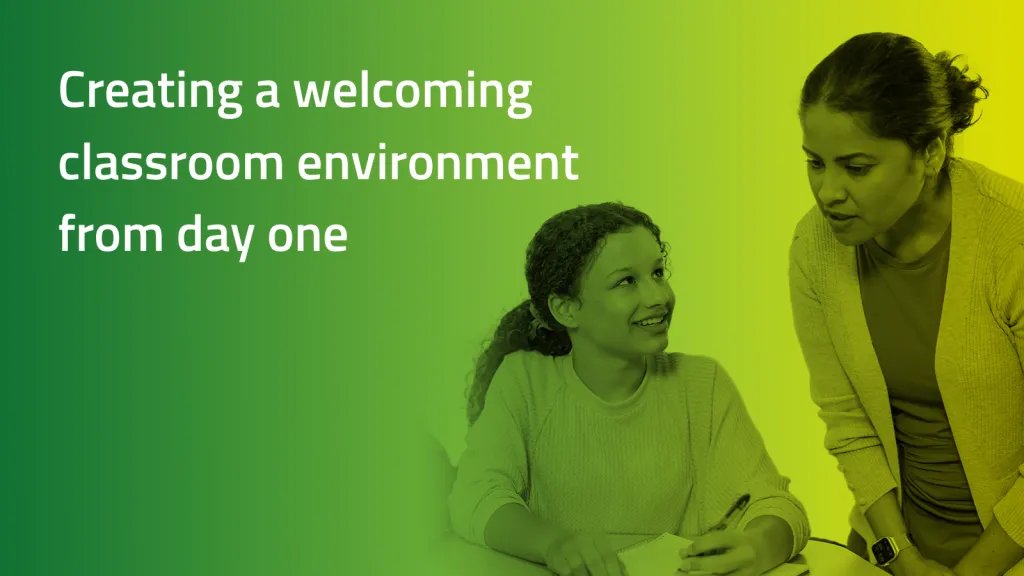Creating a welcoming classroom environment from day one


Creating a welcoming classroom environment from day one
This blog was written by Sandra Medrano-Arroyo, National Director of Multilingual Learner Success.
Educators know the first days of school are more than just icebreakers and syllabus handouts—they’re a critical opportunity to set the tone for a classroom where every student feels a sense of belonging. When students feel connected and valued from the start, they’re more likely to take academic risks, support one another, and thrive. Here’s how you can begin building a strong classroom culture grounded in relationships and meaningful engagement from day one.
1. Establish relationships with students
Students thrive in classrooms that focus on positive human connections. As John Hattie (2023) highlights: Strong teacher-student relationships have the power to significantly accelerate learning. From the moment students walk into your classroom, focus on making those relationships meaningful and impactful.
- Welcome with heart: Welcome them with a personalized letter, a motivational quote, or an inspirational poem. This small gesture can go a long way! Not only will your students feel seen, valued, and welcomed, but you’ll be setting a positive tone for relationship-building, creating a sense of belonging from the start.
- Celebrate growth: Help students track their own learning journey. Whether it's a goals notebook, portfolio, or before-and-after video recordings, providing a space for multilingual learners to observe their academic and linguistic growth can increase both their confidence and competence.
- Get to know their worlds: Use games, surveys, or casual conversations to learn about students’ lives outside of school. Ask what they enjoy doing, who their favorite person is, or how they spend their weekends. This builds trust and lets students know their experiences matter in your classroom. It also gives you the opportunity to teach with relevance, connecting new learning to their world.
2. Foster relationships among students
Creating a classroom community means helping students build respectful, empathetic relationships with one another.
- Create norms together: Involve students in co-creating classroom expectations. Ask them what respect, belonging, and kindness looks like—and feels like.
- Celebrate individual gifts: Give students space to reflect on what unique contributions they bring to the classroom community. Who loves helping others? Who’s good at interpreting for peers? These moments empower students to see themselves as valued members of the classroom.
- Decorate with student identity: Let students design the classroom with self-portraits, artwork, or cultural posters. This transforms the room into a shared, vibrant space that reflects who they are. Provide your multilingual learners with opportunities to talk about their culture, their language, and how their art connects to who they are.
3. Build a relationship with language
A welcoming environment honors the linguistic diversity that students bring into the classroom.
- Set clear language expectations: Valuing the linguistic strengths of your multilingual learners is crucial for language development. Establish content objectives that explain how language will be used. Be clear about language expectations and make sure students understand that leveraging their native language for deeper understanding is not only welcomed, but encouraged!
- Maximize cross-linguistic connections: Allow time for students to connect, compare and contrast languages. This not only enhances their metacognitive and metalinguistic skills, but helps in the transfer of concepts and skills known in one language to learn the other. It also creates a classroom culture where your multilingual learners feel comfortable sharing their language and knowledge with their peers.
When students see their languages and cultures affirmed, they are more likely to engage confidently—and learn collaboratively.
4. Cultivate a growth-oriented mindset
Interruptions in learning, including summer breaks, can be reframed as opportunities that contribute to the learning process.
- Use activities like “My Life Map” (access My Life Map in Ellevation Strategies here): Invite students to reflect on past experiences that have shaped them. This can be a drawing, a timeline, or a personal essay depending on age and language proficiency levels. Use this as a springboard to talk about identity, values, and aspirations.
- Conduct brainstorm walks: Have students reflect on what they want to learn this year. Display their responses, discuss them in small groups, or incorporate them into classroom projects. When students have ownership over what they’re learning, motivation skyrockets.
A growth mindset helps multilingual learners embrace their identities and purpose by viewing language and culture as ongoing journeys.
5. Partner with families from day one
Families are essential partners in creating a welcoming environment, and engaging them early builds trust and collaboration.
- Invite their hopes: Ask family members to write a letter to their child, sharing their hopes for the school year. These letters—written in any language—can be powerful motivators for students and reminders of the support behind them.
- Offer flexible involvement: Let families choose how they’d like to be involved. Whether it’s presenting about their career, reading to the class, or participating in cultural celebrations, every contribution adds value and strengthens the school-home connection. Involving families in the classroom community builds student pride and offers real-world learning connections.
Final thoughts
Creating a welcoming classroom isn’t about a one-time activity—it’s about the intentional, daily practice of relationship-building. From the way you greet students to how you honor their stories, languages, and families, each decision sends a message: You belong here. You matter. And we’re going to grow together.
Start strong. Start with connection. And let that connection guide the year ahead.
Bilingual, bicultural, with strong Hispanic roots, and over 25 years in education, Sandra has served the needs of multilingual learners and their families through different roles in her career. With a desire to do even more for multilingual learners, she joined Ellevation Education in 2019 where she created instructional content for dual language programs and contributed to the development of professional learning modules. Sandra is committed to supporting multilingualism and multiculturalism as pathways of success for students and their families and can now be found advocating for multilingual learners on a national level.